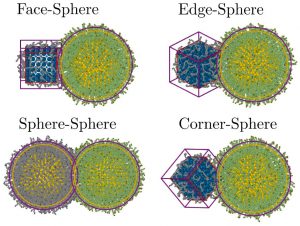June 9, 2023 — First discovered in Russia’s Ural Mountains in 1839, perovskites are minerals that scientists have long recognized for their potential around stability and efficiency in materials design. In terms of nanoscience and nanoparticles, perovskites may be able to literally change the world by enabling researchers to develop these materials with traits that seem to outshine those of today’s common materials.

In a recent study conducted using the Expanse supercomputer at the San Diego Supercomputer Center at UC San Diego, a team of scientists from the Ames National Laboratory at Iowa State University and the Swiss Federal Institute of Technology in Zürich, Switzerland, examined how to assemble perovskites that are shaped as nanocubes with other sphere-shaped nanocrystals.
Their research paper entitled Ligand Effects in Assembly of Cubic and Spherical Nanocrystals: Applications to Packing of Perovskite Nanocubes offers information about their study and the problems they observed when pairing the perovskites with spherical nanocrystals.
According to the scientists, an exciting aspect of their work was that it demonstrated the detailed verification of the Orbifold Topological Model (OTM) – a model developed in the group of Alex Travesset, a physicist at Iowa State and co-author of the paper, to predict the structure of nanoparticle arrangements.
“Advancing our ability to assemble nanoparticles, and perovskites in particular, is a necessary and important step towards accelerating this process of materials discovery – and SDSC resources make this research possible,” said Travesset.
You can read more about this story here (published April 25, 2023): San Diego Supercomputer Center’s Expanse Used for Innovative Perovskite Study.
Source: ACCESS


























































